Charles E W Bean, Diaries, AWM38 3DRL 606/259/1 - 1917 - 1927 - Part 9

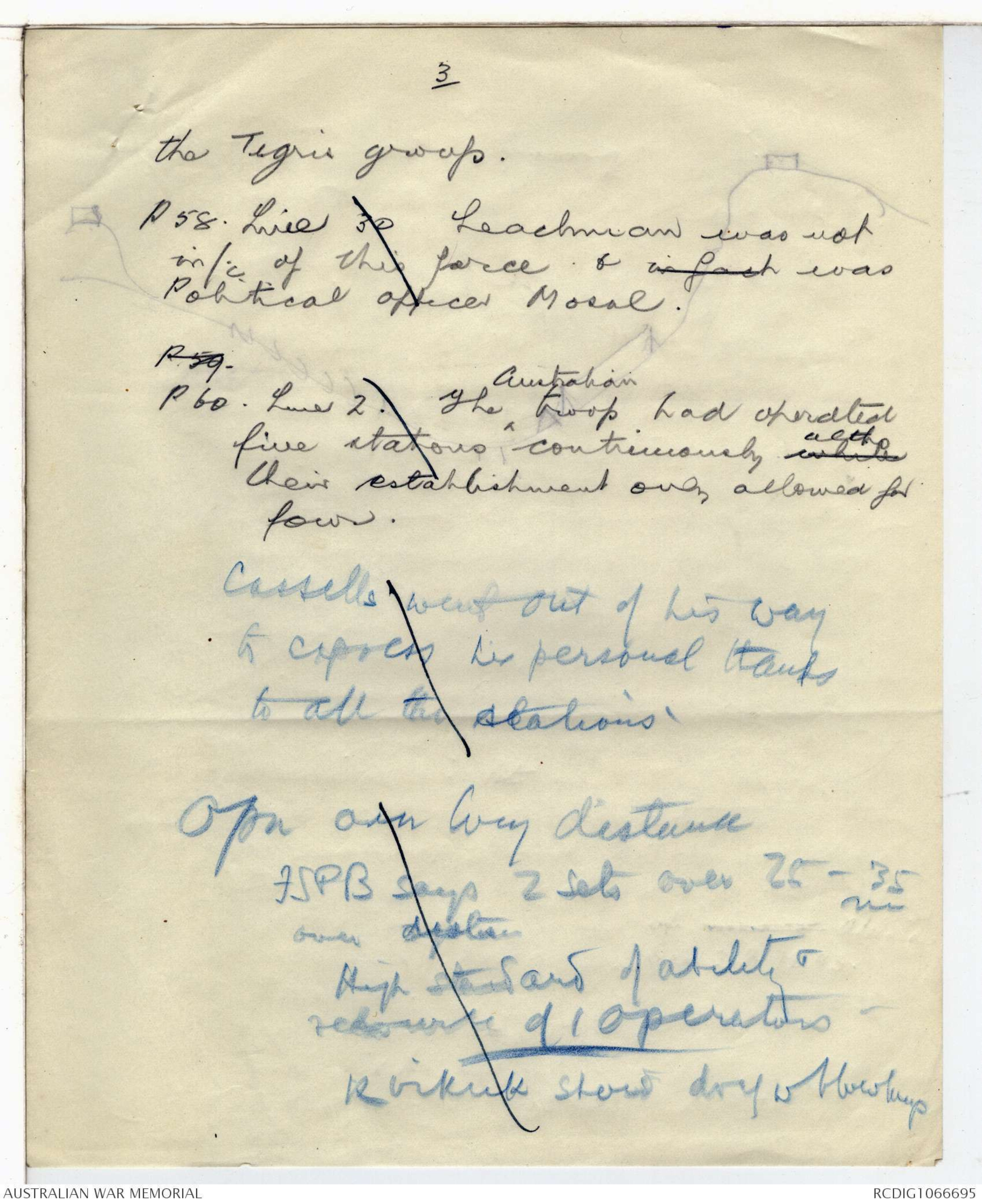
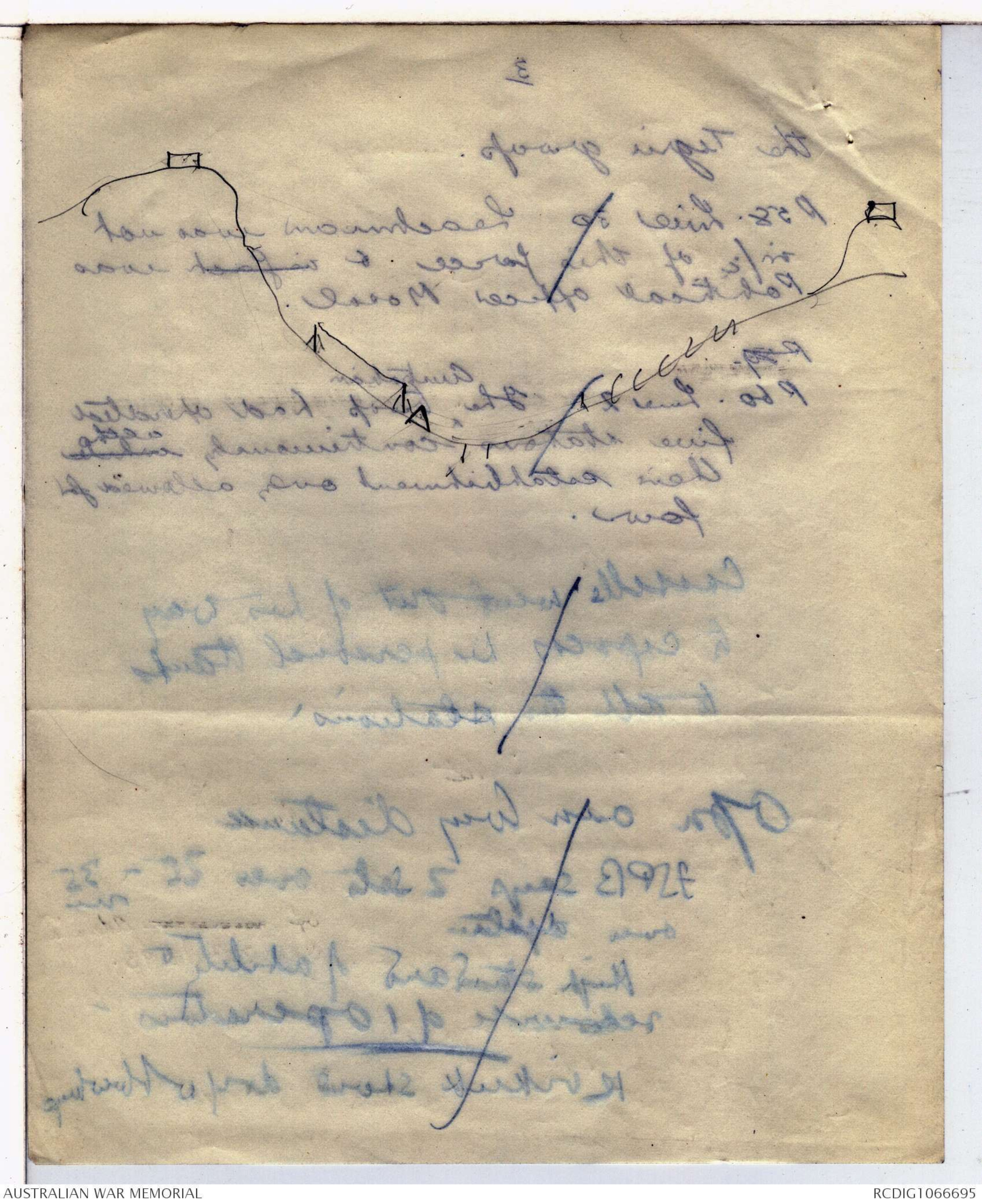
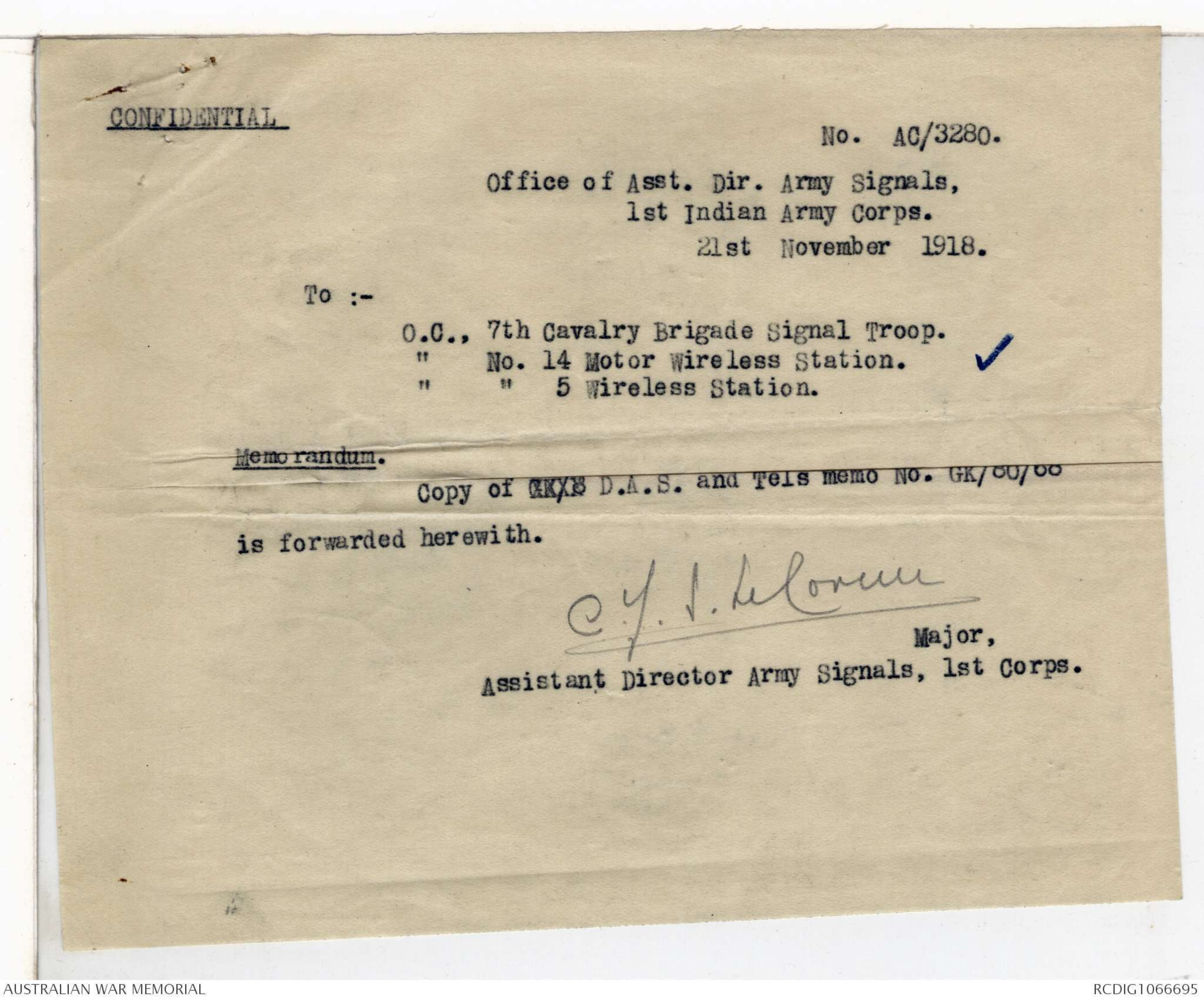
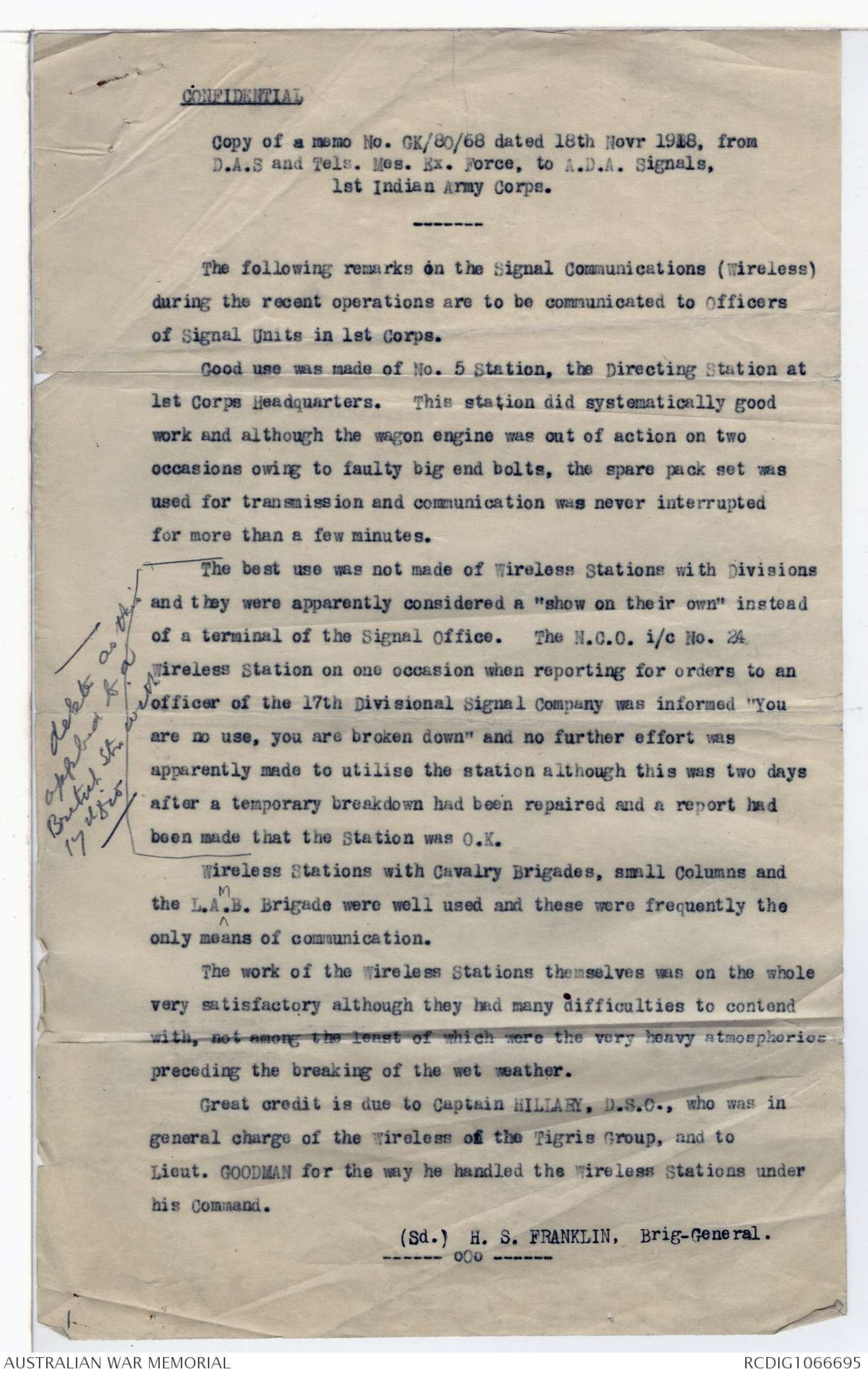

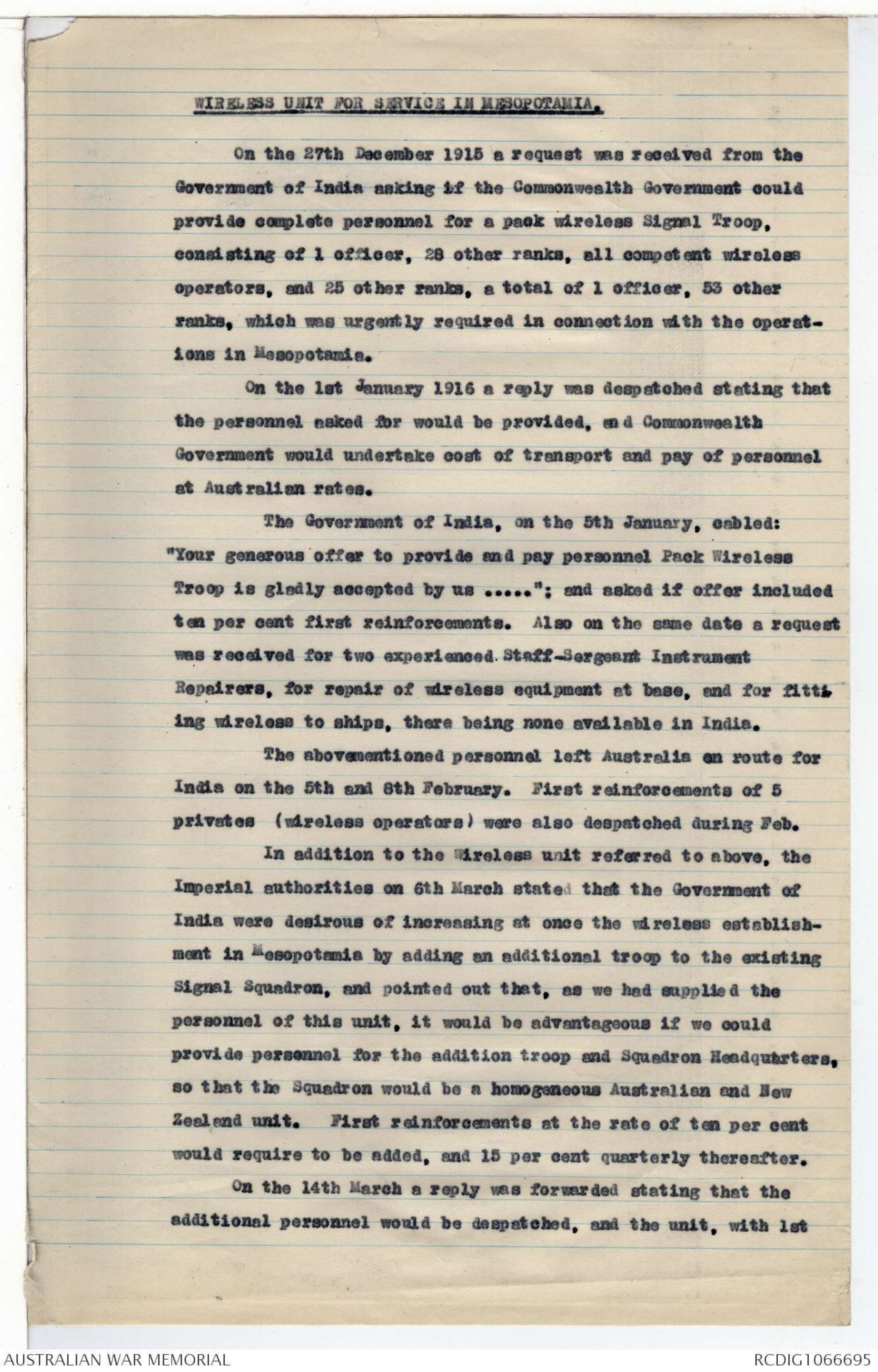
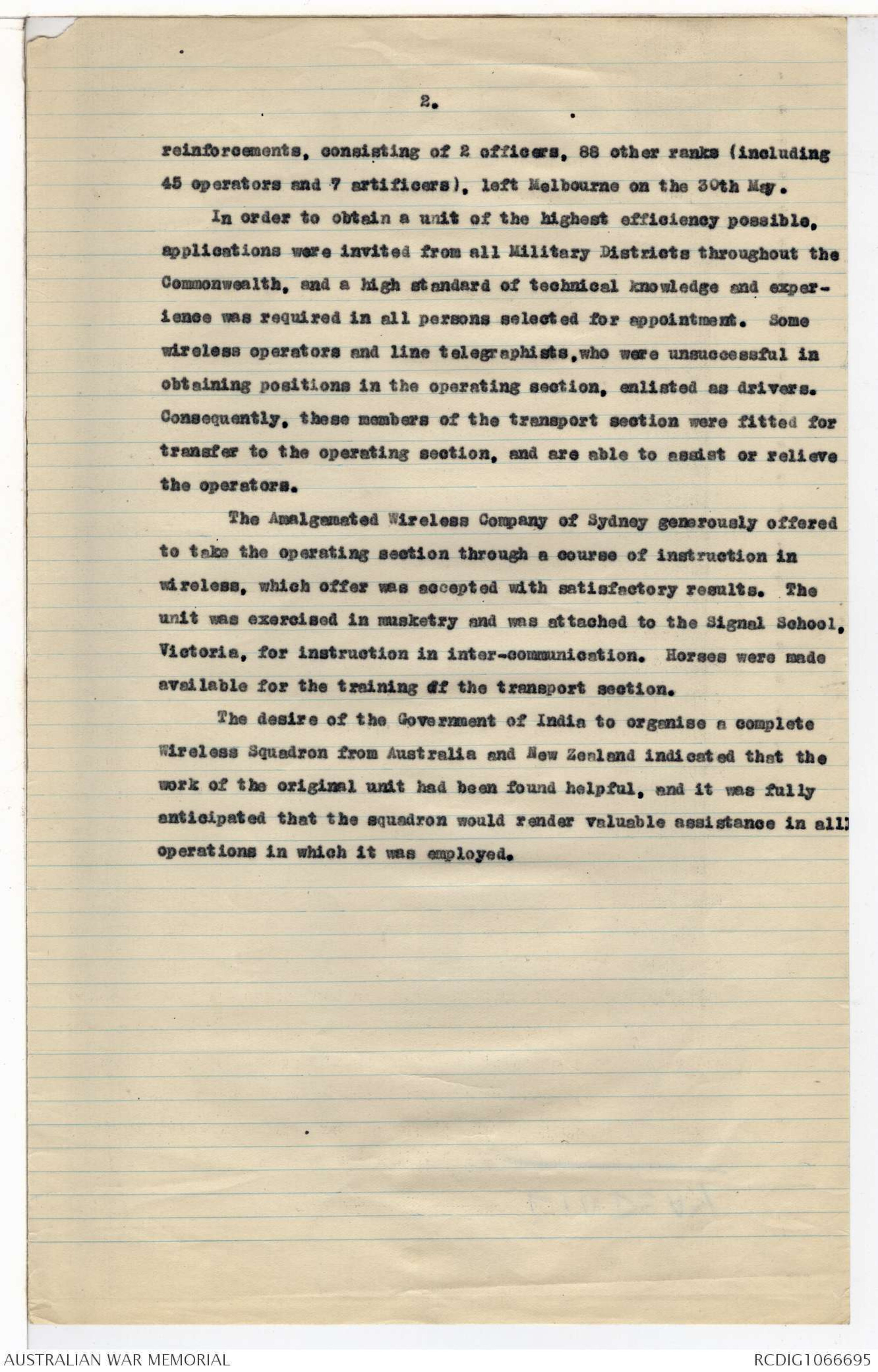
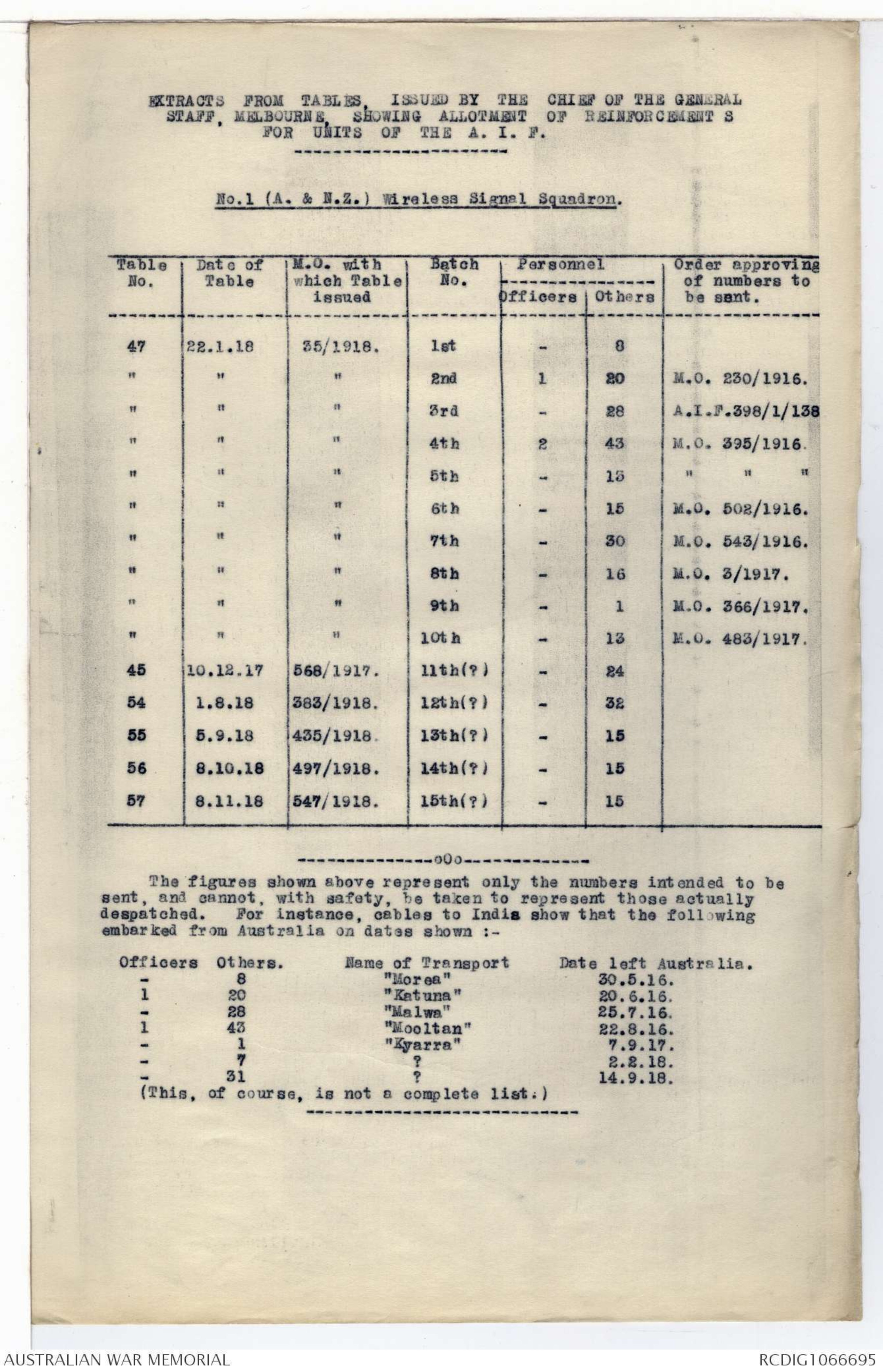

2
for the next following week.
The complicated emergency cypher
was known only to the wireless
personnel & for the rest of the
operations all enciphering &
deciphering had to be done by them
a duty ordinarily carried out by
special ^staff officers. This work in addition to
their normal duties with the quick
moving column was very arduous
but the men all ranks acquitted
themselves excellently as the following
extract from a report by the Director
of Army Signals dated 18/11/18.
P57. Line 11 Have you a footnote of
Gen Cassels now C w C in
India.
P58. Line 2 - after Stations insert
under Lieut Goodman.
Footnote - Lieut C.W. Goodman B.E.M.I.E.E.
Electrical Engineer of Sydney Adelaide
born London. Dec 30th 1893.
P58 Line 8. The Australians took
over the relatively powerful
Turkish wireless station at Mosul
which bec acted from then
onwards as directing station for
3
the Tigris group.
P58. Line 30 Leachman was not
in/c of this force & in fact was
Political officer Mosul.
P59.
P60. Line 2. The ^Australian troop had operated
five stations continuously which ^altho
their establishment only allowed for
four.
Cassels went out of his way
to express his personal thanks
to all the stations.
Opn over long distance
FSPB says 2 sets over 25-35m
over distan
High standard of ability &
resource of / operators -
[[Kirkuk]] show dry w [[?]]
Hand drawn diagram - see original document
CONFIDENTIAL
No. AC/3280.
Office of Asst. Dir. Army Signals,
1st Indian Army Corps.
21st November 1918.
To :-
O.C., 7th Cavalry Brigade Signal Troop.
" No. 14 Motor Wireless Station.
" " 5 Wireless Station.
Memorandum.
Copy of xxxx D.A.S. and Tels memo No. GK/xx/xx
is forwarded herewith.
C.F.S.Le Coruu
Major,
Assistant Director Army Signals, 1st Corps.
CONFIDENTIAL
Copy of a memo No. GK/80/68 dated 18th Novr 1918, from
D.A.S. and Tels. Mes. Ex. Force, to A.D.A. Signals,
1st Indian Army Corps.
The following remarks on the Signal Communications (Wireless)
during the recent operations are to be communicated to Officers
of Signal Units in 1st Corps.
Good use was made of No. 5 Station, the Directing Station at
1st Corps Headquarters. This station did systematically good
work and although the wagon engine was out of action on two
occasions owing to faulty big end bolts, the spare pack set was
used for transmission and communication was never interrupted
for more than a few minutes.
[*Delete as this
applied to a
British Stn with
17th Div*]
The best use was not made of Wireless Stations with Divisions
and they were apparently considered a "show on their own" instead
of a terminal of the Signal Office. The N.C.O. i/c No. 24
Wireless Station on one occasion when reporting for orders to an
officer of the 17th Divisional Signal Company was informed "You
are no use, you are broken down" and no further effort was
apparently made to utilise the station although this was two days
after a temporary breakdown had been repaired and a report had
been made that the Station was O.K.
Wireless Stations with Cavalry Brigades, small Columns and
the L.A.^M.B. Brigade were well used and these were frequently the
only means of communication.
The work of the Wireless Stations themselves was on the whole
very satisfactory although they had many difficulties to contend
with, not among the least of which were the very heavy atmospherics
preceding the breaking of the wet weather.
Great credit is due to Captain HILLARY, D.S.C., who was in
general charge of the wireless of the Tigris Group, and to
Lieut. GOODMAN for the way he handled the Wireless Station under
his Command.
(Sd.) H. S. FRANKLIN, Brig-General.
F.4151
xxxxx
1256.
22 July 1926.
E.K. Burke, Esq.,
Box 864G. G.P.O.,
Sydney.
Dear Burke,
I enclose the particulars concerning the origin
of the wireless units. I will let you know as soon as I hear
from the War Museum about the other records.
Yours sincerely,
C. E. W. BEAN
WIRELESS UNIT FOR SERVICE IN MESOPOTAMIA.
On the 27th December 1915 a request was received from the
Government of India asking if the Commonwealth Government could
provide complete personnel for a pack wireless Signal Troop,
consisting of 1 officer, 28 other ranks, all competent wireless
operators, and 25 other ranks, a total of 1 officer, 53 other
ranks, which was urgently required in connection with the
operations in Mesopotamia.
On the 1st January 1916 a reply was despatched stating that
the personnel asked for would be provided, and Commonwealth
Government would undertake cost of transport and pay of personnel
at Australian rates.
The Government of India, on the 5th January, cabled:
"Your generous offer to provide and pay personnel Pack Wireless
Troop is gladly accepted by us....."; and asked if offer included
ten per cent first reinforcements. Also on the same date a request
was received for two experienced Staff-Sergeant Instrument
Repairers, for repair of wireless equipment at base, and for
fitting wireless to ships, there being none available in India.
The abovementioned personnel left Australia en route for
India on the 5th and 6th February. First reinforcements of 5
privates (wireless operators) were also despatched during Feb.
In addition to the Wireless unit referred to above, the
Imperial authorities on 6th March stated that the Government of
India were desirous of increasing at once the wireless establishment
in Mesopotamia by adding an additional troop to the existing
Signal Squadron, and pointed out that, as we had supplied the
personnel of this unit, it would be advantageous if we could
provide personnel for the addition troop and Squadron Headquarters,
so that the Squadron would be a homogeneous Australian and New
Zealand unit. First reinforcements at the rate of ten per cent
would require to be added, and 15 per cent quarterly thereafter.
On the 14th March a reply was forwarded stating that the
additional personnel would be despatched, and the unit, with 1st
2.
reinforcements, consisting of 2 officers, 88 other ranks (including
45 operators and 7 artificers), left Melbourne on the 30th May.
In order to obtain a unit of the highest efficiency possible,
applications were invited from all Military Districts throughout the
Commonwealth, and a high standard of technical knowledge and
experiences was required in all persons selected for appointment. Some
wireless operators and line telegraphists, who were unsuccessful in
obtaining positions in the operating section, enlisted as drivers.
Consequently, these members of the transport section were fitted for
transfer to the operating section, and are able to assist or relieve
the operators.
The Amalgamated Wireless Company of Sydney generously offered
to take the operating section through a course of instruction in
wireless, which offer was accepted with satisfactory results. The
unit was exercised in musketry and was attached to the Signal School,
Victoria, for instruction in inter-communication. Horses were made
available for the training of the transport section.
The desire of the Government of India to organise a complete
Wireless Squadron from Australia and New Zealand indicated that the
work of the original unit had been found helpful, and it was fully
anticipated that the squadron would render valuable assistance in all
operations in which it was employed.
EXTRACTS FROM TABLES, ISSUED BY THE CHIEF OF THE GENERAL
STAFF, MELBOURNE, SHOWING ALLOTMENT OF REINFORCEMENT S
FOR UNITS OF THE A. I. F.
No. 1 (A. & N.Z.) Wireless Signal Squadron.
|
Table No. |
Date of Table |
M.O. with which Table issued |
Batch No. |
Personnel | Order approving of numbers to be sent. |
|
| Officers | Others | |||||
| 47 | 22.1.18 | 35/1918. | 1st |
- |
8 |
|
| " | " | " | 2nd |
1 |
20 |
M.O. 230/1916. |
| " | " | " | 3rd |
- |
28 |
A.I.F.398/1/138 |
| " | " | " | 4th |
2 |
43 |
M.O. 395/1916 |
| " | " | " | 5th |
- |
15 |
M.O. 395/1916. |
| " | " | " | 6th |
- |
15 |
" " " |
| " | " | " | 7th |
- |
30 |
M.O. 543/1916. |
| " | " | " | 8th |
- |
16 |
M.O. 3/1917. |
| " | " | " | 9th |
- |
1 |
M.O. 366/1917. |
| " | " | " | 10th |
- |
13 |
M.O. 483/1917. |
|
45 |
10.12.17 | 568/1917. | 11th(?) |
- |
24 |
|
|
54 |
1.8.18 | 383/1918. | 12th(?) |
- |
32 |
|
|
55 |
5.9.18 | 435/1918. | 13th(?) |
- |
15 |
|
|
56 |
8.10.18 | 497/1918. | 14th(?) |
- |
15 |
|
|
57 |
8.11.18 | 547/1918. | 15th(?) |
- |
15 |
|
The figures shown above represent only the numbers intended to be
sent, and cannot, with safety, be taken to represent those actually
despatched. For instance, cables to India show that the following
embarked from Australia on dates shown :-
| Officers | Others. | Name of Transport | Date left Australia. |
|
- |
8 |
"Morea" |
30.5.16. |
|
1 |
20 |
"Katuna" |
20.6.16. |
|
- |
28 |
"Malwa" |
25.7.16. |
|
1 |
43 |
"Mooltan" |
22.8.16. |
|
- |
1 |
"Kyarra" |
7.9.17. |
|
- |
7 |
? |
2.2.18. |
|
- |
31 |
? |
14.9.18. |
(This, of course, is not a complete list.)
1191.
5 July 1926.
Dear Treloar,
The Mesopotamian Units are compiling their unit history,
the committee consisting of Major Marr and a Melbourne and a
Sydney representative. It is unlikely that they will be touched
on at any length in the Official History, so this will probably
be the main book of reference, though I understand it is to be as
lightly written as possible. Have we any diaries of -
(1) the signal squadron with the Cavalry division in
Mesopotamia:
(2) the signal squadron with the Dunsterville Force; and
(3) any private diaries or documents concerning
Mesopotamia?
If so, could you let me have them here, so as to be available to
Mr. Keast Burke, who has been chosen as Editor?
I am going to try to compile a list of the Dunsterforce,
showing where each man served. Have you any data which you could send me?
Yours sincerely.
C. E. W. BEAN
Mr. J.L. Treloar,
Australian War Memorial,
Box 214D, G.P.O.,
Melbourne.
 Sam scott
Sam scottThis transcription item is now locked to you for editing. To release the lock either Save your changes or Cancel.
This lock will be automatically released after 60 minutes of inactivity.